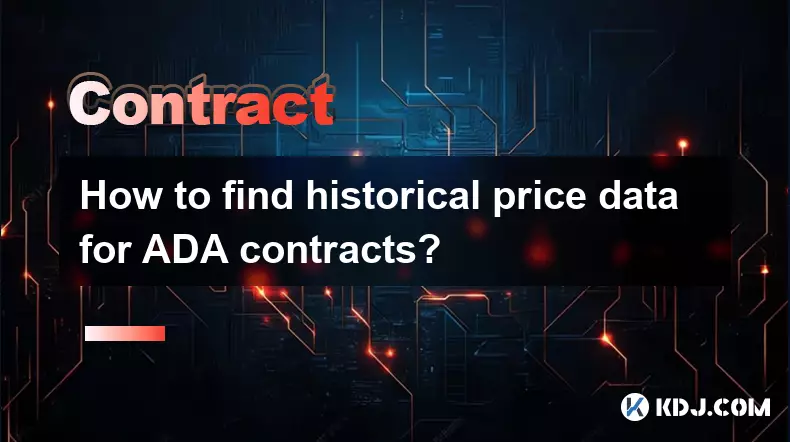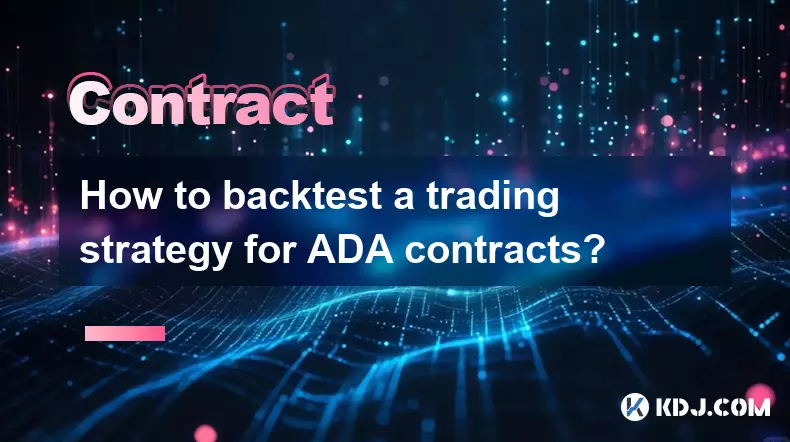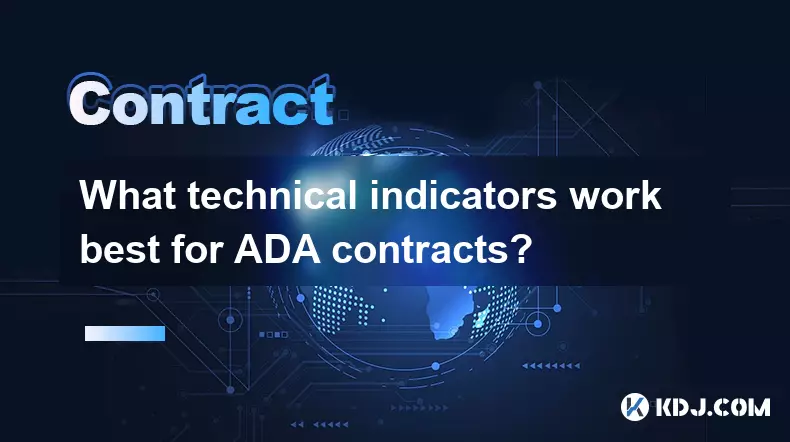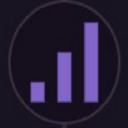-
 bitcoin
bitcoin $110323.126235 USD
1.94% -
 ethereum
ethereum $3864.833023 USD
1.25% -
 tether
tether $1.000393 USD
0.02% -
 bnb
bnb $1133.877748 USD
4.86% -
 xrp
xrp $2.393640 USD
1.11% -
 solana
solana $192.566078 USD
6.48% -
 usd-coin
usd-coin $0.999906 USD
0.00% -
 tron
tron $0.313196 USD
-2.80% -
 dogecoin
dogecoin $0.194944 USD
2.29% -
 cardano
cardano $0.643216 USD
2.65% -
 hyperliquid
hyperliquid $39.990234 USD
7.27% -
 chainlink
chainlink $17.375446 USD
0.89% -
 ethena-usde
ethena-usde $0.999536 USD
0.02% -
 stellar
stellar $0.310716 USD
0.33% -
 bitcoin-cash
bitcoin-cash $480.762464 USD
1.14%
How to read the order book for ADA contracts effectively?
The ADA order book reveals real-time buy/sell interest, with dense clusters indicating key support/resistance levels and sudden order removals signaling potential manipulation.
Oct 22, 2025 at 06:37 am

Understanding the Structure of the ADA Order Book
1. The order book for ADA contracts displays a real-time list of buy and sell orders organized by price level. On the left side, you typically see the bid prices—these are the prices at which traders are willing to buy ADA. On the right, the ask prices show where traders intend to sell. Each price level includes the volume associated with that specific order.
2. Market depth is visualized through the clustering of orders across different price points. A dense cluster on either side indicates strong support or resistance. For instance, a large stack of buy orders just below the current market price may suggest a floor forming due to accumulated demand.
3. Price levels are usually arranged in ascending order from top to bottom on the ask side and descending on the bid side. This vertical arrangement allows traders to quickly assess where liquidity is concentrated and identify potential breakout or reversal zones based on order imbalances.
4. Order books update dynamically as new trades occur or orders get canceled. Watching how rapidly certain levels fill or deplete provides insight into market sentiment and momentum shifts within the ADA futures or perpetual contract markets.
Identifying Key Levels and Liquidity Zones
1. Significant price points with high volumes of open orders often act as magnets or barriers during price movements. These zones can be identified by observing clusters where multiple limit orders reside. Such areas frequently influence short-term price action because institutional players tend to place large resting orders here.
2. Gaps in the order book—where few or no orders exist between two close price levels—can lead to rapid price jumps when triggered. If the market moves into a gap zone, especially during low-liquidity periods, slippage increases dramatically, affecting entry and exit precision for leveraged positions.
3. Traders analyzing ADA contracts should pay attention to both immediate and deeper layers of the book. Proximity to the spread matters for execution speed, but deeper levels reveal hidden intentions, such as iceberg orders masked behind smaller visible entries.
4. Repeated rejection at a certain price seen in the order flow history, combined with persistent order stacking, signals a probable support or resistance level. This becomes more reliable when aligned with technical chart patterns or moving averages on time-based candlestick charts.
Interpreting Market Sentiment Through Order Flow
1. A growing number of limit buy orders appearing below the current price suggests accumulation behavior. Conversely, expanding sell walls indicate distribution or bearish intent among larger holders managing their exposure on ADA derivative platforms.
2. Sudden removal of large resting orders—known as 'order book spoofing'—can mislead retail participants. When a massive bid or ask disappears moments before price reaches it, this manipulation tactic aims to trigger automated systems or emotional reactions. Monitoring order persistence helps filter out noise.
3. Aggressive market orders that sweep through multiple price levels reveal urgency. A cascade of market buys consuming several layers of asks shows strong bullish pressure, often preceding volatility expansions in ADA’s contract trading.
4. Real-time delta analysis, which compares aggressive buying versus selling volume, enhances interpretation. Positive delta over time amid rising prices confirms strength; negative delta during rallies hints at potential exhaustion despite upward movement.
Common Questions About ADA Contract Order Books
What does a thick sell wall mean for ADA futures?A dense concentration of sell orders at a specific price level indicates resistance. It implies that sellers are actively defending that zone, making it harder for price to advance unless substantial buying pressure emerges to absorb all offers.
How can I tell if an order book is being manipulated?Watch for large orders that appear and vanish quickly without execution. Frequent changes in top-of-book volume without corresponding price movement may signal spoofing. Consistent patterns of fake liquidity often coincide with sharp reversals after brief breakouts.
Does the order book differ between exchanges for ADA contracts?Yes. Each exchange maintains its own independent order book based on its user base and liquidity providers. Differences in depth, spread tightness, and available leverage affect how ADA contracts behave across platforms like Binance, Bybit, or OKX.
Can I rely solely on the order book for trading decisions?While informative, the order book should complement other tools like volume profiles, funding rates, and on-chain metrics. Relying exclusively on order book data risks overlooking broader market context, especially during news-driven events or macroeconomic shifts impacting crypto assets.
Disclaimer:info@kdj.com
The information provided is not trading advice. kdj.com does not assume any responsibility for any investments made based on the information provided in this article. Cryptocurrencies are highly volatile and it is highly recommended that you invest with caution after thorough research!
If you believe that the content used on this website infringes your copyright, please contact us immediately (info@kdj.com) and we will delete it promptly.
- Essex Post Office, 5p Coins, and King Charles: A Royal Mint Revelation!
- 2025-10-23 10:30:16
- Waymo's Newark Airport AV Tests: Alphabet's AI Gamble Pays Off?
- 2025-10-23 10:30:16
- King Charles 5p Coins: A Royal Flush in Your Pocket?
- 2025-10-23 10:35:18
- Solana, Crypto Advisory, and Forward Industries: A New York Minute on the Future of Finance
- 2025-10-23 08:51:22
- MAGACOIN: Ethereum Whales Dive into the Hottest Presale of 2025
- 2025-10-23 08:51:22
- Kadena's End of the Road? KDA Token Plummets Amid Project Abandonment
- 2025-10-23 08:55:34
Related knowledge

What are quarterly vs. perpetual ADA contracts?
Oct 19,2025 at 08:55am
Understanding Quarterly and Perpetual ADA ContractsDerivatives trading in the cryptocurrency space has expanded rapidly, offering traders various inst...

How to find historical price data for ADA contracts?
Oct 18,2025 at 10:18pm
Understanding ADA and Its Market Data Availability1. Cardano’s native cryptocurrency, ADA, operates on a decentralized blockchain that supports smart ...

How to backtest a trading strategy for ADA contracts?
Oct 21,2025 at 02:37pm
Understanding the Basics of Backtesting ADA Contracts1. Backtesting a trading strategy for Cardano (ADA) contracts involves applying historical price ...

How to read the order book for ADA contracts effectively?
Oct 22,2025 at 06:37am
Understanding the Structure of the ADA Order Book1. The order book for ADA contracts displays a real-time list of buy and sell orders organized by pri...

What technical indicators work best for ADA contracts?
Oct 23,2025 at 06:36pm
Understanding the Role of Technical Indicators in ADA TradingTechnical indicators are essential tools for traders analyzing Cardano (ADA) contracts. T...

How to hedge my spot Cardano portfolio with ADA contracts?
Oct 18,2025 at 05:36am
Hedging Your ADA Spot Holdings Using Derivatives1. Identify a reliable exchange that offers ADA futures or perpetual contracts. Exchanges like Binance...

What are quarterly vs. perpetual ADA contracts?
Oct 19,2025 at 08:55am
Understanding Quarterly and Perpetual ADA ContractsDerivatives trading in the cryptocurrency space has expanded rapidly, offering traders various inst...

How to find historical price data for ADA contracts?
Oct 18,2025 at 10:18pm
Understanding ADA and Its Market Data Availability1. Cardano’s native cryptocurrency, ADA, operates on a decentralized blockchain that supports smart ...

How to backtest a trading strategy for ADA contracts?
Oct 21,2025 at 02:37pm
Understanding the Basics of Backtesting ADA Contracts1. Backtesting a trading strategy for Cardano (ADA) contracts involves applying historical price ...

How to read the order book for ADA contracts effectively?
Oct 22,2025 at 06:37am
Understanding the Structure of the ADA Order Book1. The order book for ADA contracts displays a real-time list of buy and sell orders organized by pri...

What technical indicators work best for ADA contracts?
Oct 23,2025 at 06:36pm
Understanding the Role of Technical Indicators in ADA TradingTechnical indicators are essential tools for traders analyzing Cardano (ADA) contracts. T...

How to hedge my spot Cardano portfolio with ADA contracts?
Oct 18,2025 at 05:36am
Hedging Your ADA Spot Holdings Using Derivatives1. Identify a reliable exchange that offers ADA futures or perpetual contracts. Exchanges like Binance...
See all articles










































































